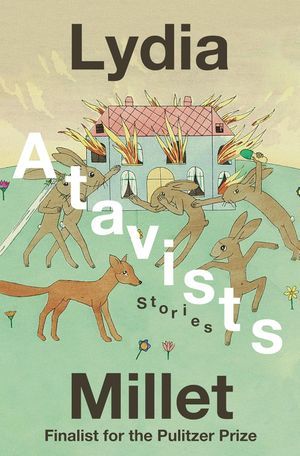
This content contains affiliate links. When you buy through these links, we may earn an affiliate commission.
This week’s featured books have scheming, secret royalty, a possessing-ghost-turned-lover, a personal history of Indian boarding schools, and more.


Atavists: Stories by Lydia Millet
These linked new stories by the award-winning author follow families, loners, and lovers, all as they wrestle with the alienation that comes with different generations and social classes. The “-ists” here are everything from insurrectionists to cosmetologists—there’s a bodybuilder who is living the life an incel wished they were; a woman who thinks her young son-in-law likes to watch older people do the nasty; and a suburban dad whose desire to host refugees in the tiny house in his backyard borders on obsession.
New Books
Subscribe to the New Books! newsletter to get weekly updates about new releases.


Zeal by Morgan Jerkins
Jerkins’ (Caul Baby) latest has this vital duality. It’s about the lasting consequences of slavery, just as it is about the power of love. It’s 1865, and Harrison has been discharged from the Union Army as a free man, so he tries to reunite with his love, Tirzah. His plans get rearranged, though, after he settles with another woman after a tragedy. Then there’s Tirzah, who teaches at the Freedman’s School. She sees an ad in the paper looking for her and knows it’s Harrison looking for her, but the state of the world, despite her new freedom, means reuniting with him is full of risk. Jerkins’ narrative sweeps over generations, and 150 years later, in 2019 Harlem, Ardelia and Oliver are hosting their engagement party, and he gives her a crumbling, aged love letter. The question of whether their connection was some sort of cosmic reconciliation, started generations ago, arises.


Great Big Beautiful Life by Emily Henry
Here, Henry is giving us writers-turned-lovers like she has before, but with a twist. The writers in question are Alice Scott, the sunshiney writer hungry for that big break, and Hayden Anderson, a Pulitzer Prize-winning grouch. The two are on an island called Little Crescent because they’re both vying to write the biography of the legendary Margaret Ives—an 80-something-year-old heiress and former tabloid princess who hasn’t been seen in years. The twist comes in the form of them both being given a one-month trial period for Margaret to see who she likes best to write her story. Thing is, she’s not actually telling them everything, and depending who’s telling her story, it could appear to be a tragedy or an homage to love. What’s more, the developing tension between the two writers is turning into its own narrative.


The Corruption of Hollis Brown by K. Ancrum
This is a queer love story unlike any I’ve ever come across. There’s Hollis, who lives in a dead-end kind of blue-collar town, and who only seems to enjoy himself when he’s with his popular girl best friends…or fighting. But his tendency to throw hands isn’t his only problem—once he meets a stranger named Walt, he ends up making a deal at the crossroads. Now, he’s losing control of his body and mind to Walt, a ghost with a violent past who has some scores to settle. The two of them eventually start working together to achieve Walt’s goal, but then they grow closer. The resulting bond becomes romantic, and I’m sure I don’t have to tell you how awkward it is to low-key be in love with the ghost who’s possessing you.


Medicine River: A Story of Survival and the Legacy of Indian Boarding Schools by Mary Annette Pember
This chronicles the very deliberate effort to destroy First Nations communities and cultures by way of cultural genocide. From the mid-1800s to the late 1930s, tens of thousands of Indigenous American children were stolen from their families and forced to go to boarding schools that were sponsored by the US government—and which had virtually no regulation. At the schools, they were abused and discouraged from engaging in their traditions and culture through violence. Ojibwe journalist Mary Pember explores the long-term ramifications of attending these loveless institutions, detailing how her mother, having attended one, set the stage for a fraught mother-daughter dynamic.


The Pretender by Jo Harkin
This has been likened to the historical fiction of writers like Hilary Mantel and Maggie O’Farrell, and I have to say that I can see it reaching the level of popularity and acclaim that books by those authors did—at least partially because it’s so messy.
So let’s get to the mess: in 1480, John Collan is attending to his peasant duties (which involve a goat) when he’s approached by a well-dressed stranger who tells him that his whole life has been a lie. He’s not John at all, but Lambert Simnel, son of the long-dead Duke of Clarence, and sent away because the Duke’s brother, Richard III, liked to unalive his nephews. Well, now that his true identity has been revealed, John-now-Simnel is sent to court in Ireland, learns etiquette, and even meets the delightfully manipulative—and occasionally murderous—Joan, the daughter of his Irish patrons. In a way, the two aren’t so different—she can either go to the convent or to the wedding altar, and he can be king or die. That’s why they come together to plot and scheme, changing the course of England forever.
Other Book Riot New Releases Resources:
- All the Books, our weekly new book releases podcast, where Liberty and a cast of co-hosts talk about eight books out that week that we’ve read and loved.
- The New Books Newsletter, where we send you an email of the books out this week that are getting buzz.
- Finally, if you want the real inside scoop on new releases, you have to check out Book Riot’s New Release Index! That’s where I find 90% of new releases, and you can filter by trending books, Rioters’ picks, and even LGBTQ new releases!
The following comes to you from the Editorial Desk.
This week, we’re highlighting a post that had our Managing Editor Vanessa Diaz feeling a type of way. Now, even five years after it was published, Vanessa is still salty about American Dirt. Read on for an excerpt and become an All Access member to unlock the full post.
Picture it: The United States, January 2020. A book with a pretty blue and white cover is making the rounds on the bookish internet. The blue ink forms a beautiful hummingbird motif against a creamy background, a bird associated with the sun god Huitzilopochtli in Aztec mythology. Black barbed wire, at once delicate and menacing, cuts the pattern into a grid resembling an arrangement of Talavera tiles. The package is eye-catching, ostensibly Mexican in feel, and evocative of borders and the migrant experience.
The book tells the story of a bookstore owner in Acapulco, Mexico, who is forced to flee her home when a drug cartel murders everyone in her family except for her young son at a quinceañera. She and the boy are forced to become migrants and embark on a treacherous journey north to the U.S. border, evading the cartel and befriending fellow migrants along the way. The book is being lauded not just as the “it” book of the season but as the immigration story. It gets the Oprah treatment and is praised by everyone from Salma Hayek to the great Sandra Cisneros, who called it “the great novel of Las Américas.”
It’s been over five years, and this book is still the bane of my existence.
Sign up to become an All Access member for only $6/month and then click here to read the full, unlocked article. Level up your reading life with All Access membership and explore a full library of exclusive bonus content, including must-reads, deep dives, and reading challenge recommendations.

